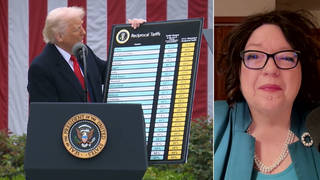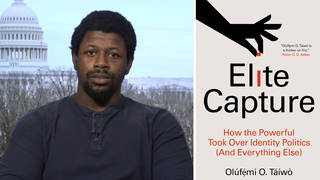
Guests
- Mariko Lin Changchief author of the study “Lifting as We Climb: Women of Color, Wealth and America’s Future.” Author of the forthcoming book Shortchanged: Why Women Have Less Wealth and What Can Be Done About It.
- C. Nicole MasonExecutive Director of the Women of Color Policy Network at the Wagner Graduate School of Public Service at New York University. Last year she published a study titled “Race, Gender and the Recession.”
The Insight Center for Community Economic Development released a report on the gender wealth gap to mark International Women’s Day. The report found nearly half of all single black and Hispanic women have zero or negative wealth, meaning their debts exceed all of their assets. The median wealth for single black women is only $100; for single Hispanic women, $120. This compares to just over $41,000 for single white women. We speak with the chief author of the report, Mariko Lin Chang and C. Nicole Mason, Executive Director of the Women of Color Policy Network. [includes rush transcript]
Transcript
JUAN GONZALEZ: On Thursday, members of the Congressional Black Caucus held a rare one-hour meeting with President Obama to pressure him to create jobs in the black community. Congresswoman Barbara Lee said, quote, “We talked about the desperation that we’re feeling in our communities throughout the country.”
While the nation’s official unemployment rate stands at 9.7 percent, it is nearly 16 percent among African Americans and 12.4 percent among Latinos. The impact of the recession has also been particularly hard on African American and Latino workers due to the longstanding wealth gap in the country. For every dollar of wealth owned by the typical white family, the typical family of color owns only 16 cents. And for single women of color, the wealth gap is far wider.
Earlier this week, the Insight Center for Community Economic Development released a report on the gender wealth gap to mark International Women’s Day.
AMY GOODMAN: The report found nearly half of all single black and Hispanic women have zero or negative wealth, meaning their debts exceed all their assets. The median wealth for single black women is only $100; for single Hispanic women, $120. This compares to just over $41,000 for single white women. About a third of single Hispanic women and one-fourth of single black women have no checking or savings account. The study is called “Lifting as We Climb: Women of Color, Wealth and America’s Future.”
We’re joined in Boston right now by the chief author of the report, Mariko Lin Chang. She is the author of the forthcoming book Shortchanged: Why Women Have Less Wealth and What Can Be Done About It.
And here with us in New York, Nicole Mason. She’s the executive director of the Women of Color Policy Network at the Wagner Graduate School of Public Service at New York University. Last year she published a study called “Race, Gender and the Recession.”
We welcome you both to Democracy Now! Mariko Lin Chang, let’s begin with you. You authored this latest report. Go through these numbers again, but start by talking about what is the difference between wealth and income.
MARIKO LIN CHANG: Sure. We are used to thinking about how well people are doing financially in terms of their income or how much money flows into a household over a period of time, usually from wages or salary. However, income is really just the tip of the iceberg. Wealth inequality is much greater than income inequality and is much more consequential.
Now, wealth refers to the value of your assets, such as money held in checking or savings accounts, retirement benefits, your home or business assets, minus the value of your liabilities or debts, including things like your mortgage, credit card debt or other loans. Now, wealth has many benefits that income doesn’t. For example, it can be passed down from generation to generation. Wealth can be used as collateral for loans. And it can also generate income for people, in terms of dividends or rents, for example.
But the current economic crisis has shown us just how important it is for people to have wealth. Wealth, in the form of savings or financial assets, per se, allow people to make ends meet when their incomes are temporarily cut or whether they’re lost, as we’ve seen now in times of high unemployment. And also that happens to people when they face an illness and are no longer able to work.
Now, the racial wealth gap has received growing attention, and rightly so. However, the wealth gap for women has received very little attention, let alone the wealth gap for women of color. That’s why the Insight Center’s report, as part of the Closing the Racial Wealth Gap Initiative that’s directed by Meizhu Lui, should be commended for drawing our attention to the tremendous wealth gap that’s faced by women of color.
JUAN GONZALEZ: Well, for instance, when you point out the fact that it’s $100 in net wealth for African American women, $120 for Hispanics, $41,000 for white women, single white women, how does that compare to men?
MARIKO LIN CHANG: Right. Well, one of the most shocking findings of this report is that women of color own only a penny for every dollar of wealth owned by their corresponding men of color, of their same race. And in comparison to white women, women of color own only a fraction of a penny for every dollar of wealth owned by white women.
So one of the things that this report is showing us is that we’ve really missed a lot of information about the situation for women of color, because their situation, with respect to wealth, is not identical to men of color and is not identical to women. They face a double wealth disadvantage of being both a person of color and a woman.
AMY GOODMAN: Nicole Mason is also with us in New York. Nicole, the Forbes 500 richest people has just come out. Talk about that in relation to this report.
C. NICOLE MASON: Well, I think this is really important, especially on the — the Forbes report was released on the — right after the Insight report. And what we found is that there are 300 — nearly 300 new billionaires that made the Forbes list. And what I find very interesting is, in these hard economic times when people are struggling to make ends meet, we can have 300 new billionaires and be celebrating that as some sort of accomplishment.
And it also brings to light the ever-widening gap between people who have wealth and continue to accumulate wealth, because it’s something that continues to happen over time, and continue to build, and those who do not. In these hard economic times, they have very little assets to pull on and continue to lose ground.
JUAN GONZALEZ: And to what degree is a federal policy or tax policy, or otherwise, helping to fuel that gap as opposed to diminish it?
C. NICOLE MASON: Well, I mean, you know, under Bush, there was significant amount of tax cuts given to upper-income — to the people living in the upper income and very little recessions or benefits given, or tax credits given, to low-income and working families. And so, the situation that we’re in now is that, you know, the gap has widened, and low-income and working families continue to suffer.
And so, when we think about what needs to happen and what corrections that need to be made along the way in this current administration, we need to think about rolling back some of those tax credits. We need to think about increasing tax credits for working and low-income families, like the earned-income tax credit, childcare — the childcare credit, dependant credits. We really need to figure out how we make it so that working-class and low-income individuals can keep more of their income and invest, and invest in their families and their families’ futures.
AMY GOODMAN: And where does jobs fit into this picture?
C. NICOLE MASON: Well, again, I want to echo a point that Mariko made, that income is not necessarily connected to wealth. And when we think about jobs and jobs creation, what we have to know is that — we know that women of color and families of color have less wealth, but when we talk about job creation and recovery, that the jobs that are being created are not necessarily going to have a direct impact on communities of color, women of color. For example, in the Reinvestment Act, thinking about job creation, over 3.7 million jobs were supposed to be created, but less than a fraction of those jobs were going to go to communities of color. And then we look at the industries targeted for job creation, women of color, people of color occupied less than ten percent of those jobs. So we have to do better.
AMY GOODMAN: We’re going to go to break, then we’re going to come back to this discussion. Mariko Lin Chang is with us in Boston. “Lifting as We Climb: Women of Color, Wealth and America’s Future” is her report. And Nicole Mason, executive director of the Women of Color Policy Network at NYU is with us in New York.
This is Democracy Now! Back in a minute.
[break]
AMY GOODMAN: Our guest in Boston, Mariko Lin Chang, her report is “Lifting as We Climb: Women of Color, Wealth and America’s Future.” And Nicole Mason, executive director of the Women of Color Policy Network at New York University here in the city. I’m Amy Goodman, with Juan Gonzalez. Juan?
JUAN GONZALEZ: Yes. Well, Mariko Lin Chang, I’d like to ask you about the issue in your report that you touch on home ownership. You say that only 33 percent of African American single women and 28 percent of Hispanic single women are homeowners, compared to 57 percent of single white women. To what degree do you sense that the mortgage crisis and the homeowners crisis that we’ve been — the country has been going through has exacerbated this alarming statistic in itself?
MARIKO LIN CHANG: Well, the subprime home mortgage crisis has really hit women of color disproportionately hard. They were targeted for subprime loans. And a study by the National Council of Negro Women found that women of color were between one-and-a-half and two-and-a-half times more likely to receive subprime home loans, even when you control for income. In fact, the disparities actually increased when income increased.
Now, very sadly, many of these women of color who received subprime home loans could have qualified for conventional loans. And the study revealed that the cost to the borrower over the lifetime of these loans will cost them additional $50,000 to $100,000. So this is money that’s not going into their home equity, money that’s not going into their retirement savings. And as a result, they were left incredibly financially vulnerable. And now you see that playing out in the foreclosure crisis, as well.
AMY GOODMAN: I want to turn to the voices of some single mothers here in New York talking about working and wealth.
MARCY SHANNON: My name is Marcy Shannon, and I’m living right here in Manhattan, Harlem, Manhattan. Now, one of the big issues that we’re having is with, you know, single parents. You know, we tend to be the breadwinner for children. And a lot of time what is happening now is that because we have to spend so much time with our kids — because, first of all, it’s hard to get a job. And with this recession, it’s even more difficult. And having kids and having no father around to basically help out with our kids, then you find that sometimes we have to stay home. We can’t take the jobs that they may be presented to us. Sometimes we are not even that educated, you know, to get suitable jobs.
Now, think about saving. We can’t even have a bank account, because the bills. Think of rent, especially here in Manhattan. You’re looking at a one-bedroom apartment, even a studio, for $1,400. Think of how much you get for pay after tax is taken out. Sometimes you may be taking home $300 a week. What can that do? You can’t — you have to think about food. So there’s no money that you could — well, you call that “discretionary income.” You can’t put any money in the bank. And if you even do put any money in the bank, you end up going back the next day to use it, maybe end up in overdraft, which becomes another issue. So it’s extremely difficult for single parents.
JENNIFER FERNANDEZ: My name is Jennifer Fernandez. I live in the Bronx. It’s very difficult. I’m a single mom, working a full-time job. And like, it’s very hard to basically take care of my two kids on my own. Can’t really spend time with them. I can’t hardly sometimes pay the bills. Like, it’s so hard when you’re on your own. It’s very hard, because I can’t really save, not on, you know, a minimum job, no. Month to month is very hard. Babysitting money, the rent, the light, food — you know, that’s basically it.
MARY DYE: My name is Mary Dye, and I live in Harlem. I find that it’s very — extremely difficult to try to raise children here in Harlem at this time, this day and time. It’s awfully hard with the economy going bad, and everyone’s losing their jobs. Fortunately, I haven’t lost my job at this time. But to make ends meet, it’s just pretty much — it’s a little difficult. Hopefully I don’t run into any circumstances where I’ll be set back in debt, and hopefully the economy will get better and there’ll more chances and opportunities for minority women. Accumulating wealth is a bit hard at this time. Affordable housing really isn’t affordable housing. Everything is going up. Hopefully I won’t have to pay for a metro card for my daughter to go to school next year.
JUAN GONZALEZ: The voices of single mothers, working mothers in Harlem. I’d like to ask you, Nicole, about the stimulus plan. The Obama stimulus was supposed to create millions of new jobs and to stem the economic crisis in the country. How has it affected African Americans and Latinos across the country?
C. NICOLE MASON: Well, I think it’s safe to say that we really don’t know, but what we conjecture is that because the unemployment rate continues to go up in those communities, that the stimulus monies has not had the impact that the administration would have hoped. And because of the targeted industries targeted in the stimulus bill, and we know the underrepresentation of blacks and Latinos in those occupations, it’s going to be really hard to reach blacks and Latinos in terms of job creation and making sure that they get jobs. And when we look at the number of contractors, number of contracts that went to African American and Latinos, we see that less than five percent of contracts went to those communities. So we can again conjecture that the dollars are not reaching those communities in real ways.
AMY GOODMAN: We just have thirty seconds, but recommendations?
C. NICOLE MASON: Well, I think, first and foremost, we need — the administration needs to start to think about targeted support to black and Latino communities or communities that are disproportionately impacted by unemployment, and also start to make corrections for this — I mean, the wealth gap is something that didn’t happen overnight. It took, you know, years and years to create. And so, we really have to start thinking about policies and opportunities for us to begin to rethink what it means to be living and working in the States.
AMY GOODMAN: And Mariko Lin Chang, following up on what Nicole just said, that issue of the wealth gap coming from past inequities?
MARIKO LIN CHANG: That is absolutely correct, because one of the reasons why the wealth gap is so difficult to eradicate is because wealth is transferred from generation to generation. And so, we see those effects of, you know, prior policies that prevented many people of color from building wealth to the same extent, are still being felt today.
But there is an important point that I want to make sure that the listeners understand. And that is that when we think about jobs, we need to think not just about income, but about access to what I’ve termed the wealth escalator. And one of its important components are the fringe benefits that come with jobs that do let people translate their income into wealth more effectively, those things like paid sick days, job-related health insurance or retirement benefits. Those are things that women, and women of color in particular, are least likely to have in the types of jobs that they hold. Women of color and women are much more likely to work in service occupations, and those jobs are the least likely to come with those benefits.
So, as we heard from the women on the street, there’s much more to wealth creation than simply income. And in fact, even if men and women had the same incomes, if nothing else changed, there would still be a wealth gap for women and a wealth gap for women of color, because they lack access to the wealth escalator, the fringe benefits and the government benefits that are already helping other people build wealth, and because they’re more likely to be single parents. And as custodial parents, they bear a disproportionate financial burden of the cost of parenthood, and they have less disposable income to save and invest. So we really need to look beyond income to think about wealth, if we’re really going to improve the lives of women and women of color.
AMY GOODMAN: Mariko Lin Chang, we want to thank you for being with us. The report for Insight is called “Lifting as We Climb: Women of Color, Wealth and America’s Future.” And thank you, Nicole Mason, executive director of the Women of Color Policy Network at New York University. The report she did last year, “Race, Gender and the Recession.”












Media Options